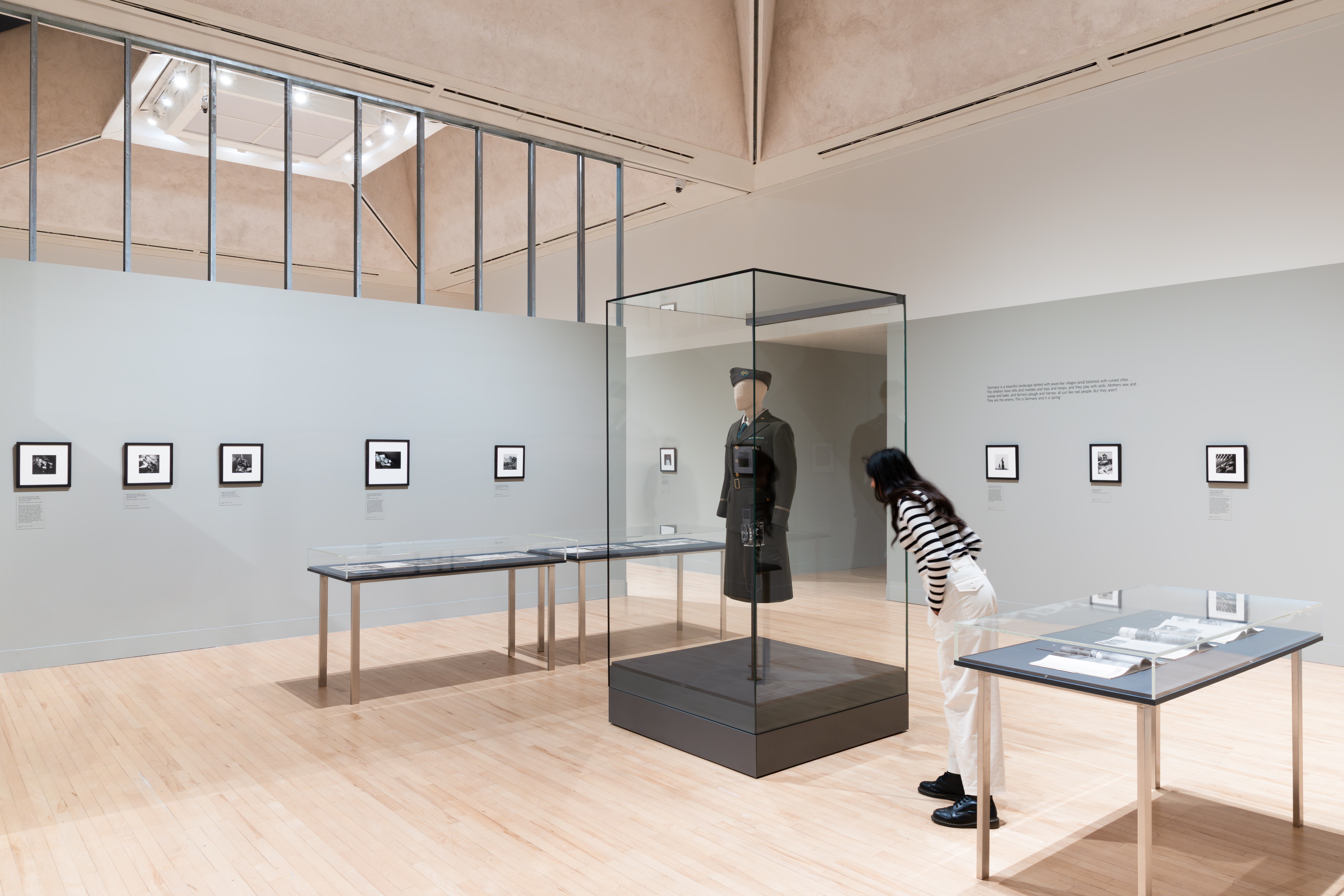In the black-and-white portrait photograph, model and photographer Lee Miller stands beside Marion Morehouse Cummings, a fashion model and the wife of American poet and painter E. E. Cummings, as they pause for photographer and designer Cecil Beaton.
Their slightly androgynous silhouettes, topped with cropped bobs, frame the entrance of a room (it has a mythical je-ne-sais-quoi) as if they are guarding the doorway or inviting the viewer inside.
Behind them: a chandelier, a fireplace, a mirror, velvet chairs, the décor, as the photograph’s note explains, of “the luxurious New York apartment of publishing magnate Condé Nast”. “Cecil Beaton, like Miller, was at the beginning of his career when he made this image,” the photograph’s note says. “Their dramatic makeup and ultra-modern drop-waisted dresses contrast with the traditional interior. Beaton admired Miller’s perceived androgyny. He later described how she had ‘cut short her pale hair and looked like a sunkissed goat-boy from the Appian Way’.”
That photograph, its theatricality, the poised drama of the interior, and the era’s effortless nonchalance, captures, in essence, the intersection of Lee Miller and Cecil Beaton’s paths: Condé Nast, and more specifically, Vogue. Both photographers worked for the magazine, each bringing a distinct visual language: their style, personal influences (hers rooted in the Surrealist movement, his in theatre and costume design), colour, and composition worlds apart, yet both driven by an unmistakable flair for mise-en-scène.
Two exhibitions, one at Tate Britain and another at the National Portrait Gallery, seem to bring them back together, albeit separately. The resemblances feel like a conversation carried across London’s streets: images spread across walls like layered wallpaper, others evoking fashion, war, and a remarkable surge of creativity.
/file/dailymaverick/wp-content/uploads/2025/10/3.-Lee-Miller-Model-Elizabeth-Cowell-wearing-Digby-Morton-suit-London-1941.-Lee-Miller-Archives.jpg)
If you can, try to see both exhibitions back-to-back over one weekend, it would be a gift to yourself. Yes, it will be busy; when I visited the Lee Miller show on a recent rainy Sunday, the crowd was so dense that raindrops seemed to literally jump from one coat to another. But the juxtaposition of the two exhibitions felt like discovering or rediscovering not only two of the most remarkable photographers of the mid-century, but also paging through a vivid visual chapter of British Vogue, as shaped by the visionary editor Audrey Withers.
What will you see? Well, both Miller’s and Beaton’s exhibitions unfold in a “loosely” chronological manner, moving through their careers and influences. It’s impossible not to be struck (and intimidated!) by their prolific artistry and the apparent ease with which they shift from one world to another, from one medium to the next.
If you follow the natural flow of each exhibition, you will move through their photographs as through their lives: their journeys, their travels, the cities they called home (Paris, Hollywood, New York!), and the people they met.
For Miller, for example, it will be her encounter with Jean Cocteau and Man Ray, the discovery of solarisation (the technique where a photograph is briefly exposed to light mid-development, creating dreamy and halo-like effects), the surrealist-like landscapes in Egypt, the beautiful nudes.
For Beaton, it’s his chic, full-of-confidence caricatures and illustrations, his portraits and his fabulous set pieces, like Shooting Star, where he photographed Nancy Beaton dressed for the Galaxy Ball. She looks like everything at once: a goddess, a siren, or a goddess emerging from the sea (her costume was pale blue and green, though in the black-and-white photograph you would never know); and of course, the costumes of My Fair Lady. You will also see his portraits of Coco Chanel and her great rival, Elsa Schiaparelli, to name only a few.
The mood through these rooms is playful, experimental and collaborative. Walking through feels like stepping into the minds of two brilliant young artists, catching their first hesitations, the bursts of confidence, the encounters that shaped their vision, their extraordinary work.
/file/dailymaverick/wp-content/uploads/2025/10/Installation-Photography-of-Lee-Miller-at-Tate-Britain-2-October-2025-%E2%80%93-15-February-2026-1.jpeg)
/file/dailymaverick/wp-content/uploads/2025/10/2.-Lee-Miller-David-E.-Scherman-dressed-for-war-London-1942.-Lee-Miller-Archives.-%C2%A9-Lee-Miller-Archives-England-2025.-All-rights-reserved.-leemiller.co_.uk_.jpg)
/file/dailymaverick/wp-content/uploads/2025/10/Worldly-Colour-Charles-James-evening-dresses-1948.-Original-colour-transparency.-The-Cecil-Beaton-Studio-Archive.jpg)
/file/dailymaverick/wp-content/uploads/2025/10/Cecil-Beaton-c.1935-Gelatin-silver-print-The-Cecil-Beaton-Studio-Archive-London.jpg)
/file/dailymaverick/wp-content/uploads/2025/10/Audrey-Hepburn-in-costume-for-My-Fair-Lady-1963.-Original-colour-transparency.-The-Cecil-Beaton-Archive-London.jpg)
And then comes the war. The change isn’t sudden, but you notice it: the light softens, the air feels heavier, visitors stop talking (or maybe that hush was just in my mind). It might be because I saw Miller’s exhibition last, but her war photographs stayed with me long after I left the National Portrait Gallery. The images are harrowing, disturbing, yet impossible to look away from.
Both Miller and Beaton brought Vogue readers straight into the Second World War. It’s that tension, between fashion and war, then simply war, that unsettles you. An image can be both beautiful in its composition and horrific in its content; or just horrific. But that is, in my mind, the dissonance they captured so precisely.
In the Miller exhibition, one quote on the wall reads: “Germany is a beautiful landscape dotted with jewel-like villages [and] blotched with ruined cities… The children have stilts and marbles and tops and hoops, and they play with dolls. Mothers sew and sweep and bake, and farmers plough and harrow; all just like real people. But they aren’t. They are the enemy. This is Germany and it is spring.”
Beyond the extraordinary photographs (and other objects exhibited), what will stay with you is the fullness of the photographers themselves, their ability to hold complexity, to see the world in shades, and to bring work that is both nuanced and so deeply human. DM




 Lee Miller's exhibition at Tate Britain. (Photo: Courtesy of Tate Britain)
Lee Miller's exhibition at Tate Britain. (Photo: Courtesy of Tate Britain)